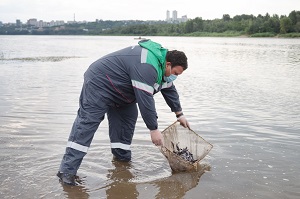Bashneft: Released 1.2 million Fry of Valuable Fish Species into Water Bodies in 2020
During the summer-autumn period of 2020, ANK Bashneft (part of the structure of NK Rosneft) replenished the water bodies of the Republic of Bashkortostan, the Nenets and Khanty-Mansiysk Autonomous Districts with young valuable fish species. The total number of released whitefish, sterlet and salmon fry was 1.2 million. This is the largest release of juvenile fish over the past 10 years under the Bashneft program for the artificial reproduction of aquatic biological resources.
Young whitefish breeds – about 880 thousand individuals, before being released into the Sula River in the Nenets Autonomous Okrug, spent seven months in special incubators and gained the mass necessary for adaptation. The fry were taken to their permanent habitat by helicopter.
 For stocking the Ob River in the Khanty-Mansiysk Autonomous Okrug, the company prepared and released 147 thousand peled fry. They were raised in the same river under special conditions, when the nursery is separated from the reservoir by a special gateway until the fry reach sufficient size. Such conditions provide a favorable natural environment for fish growth and almost completely exclude the period of adaptation of fry after entering a large river.
For stocking the Ob River in the Khanty-Mansiysk Autonomous Okrug, the company prepared and released 147 thousand peled fry. They were raised in the same river under special conditions, when the nursery is separated from the reservoir by a special gateway until the fry reach sufficient size. Such conditions provide a favorable natural environment for fish growth and almost completely exclude the period of adaptation of fry after entering a large river.
In the main region of Bashneft’s production activity – the Republic of Bashkortostan, more than 150 thousand sterlet fry were released into the Belaya River, the Pavlovskoye, Nizhnekamskoye and Votkinskoye reservoirs. The young of the year of the local Kamsko-Belskaya population of sterlet were preliminarily reared. In the fish farm, they gained about 10 grams, which increases the chances of survival of this fish in the Ural climate.
Before releasing fry into the river, the temperature of the water in the containers is gradually equalized relative to the water body (river or reservoir). Then the fry are moved to their new habitat, where they can give birth in a year.
The stocking sites were determined by the Federal Agency for Fishery and agreed with the regional departments of state control, supervision and protection of aquatic biological resources.
Activities on artificial stocking of water bodies in Russia are carried out within the framework of the implementation of the strategic objectives of Rosneft in the field of environmental protection, including a set of measures to protect ecosystems and biodiversity, and restore natural resources.











